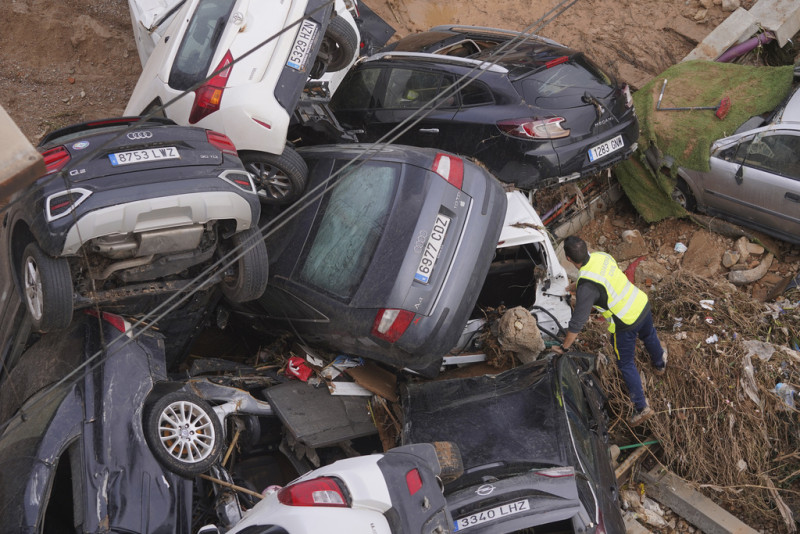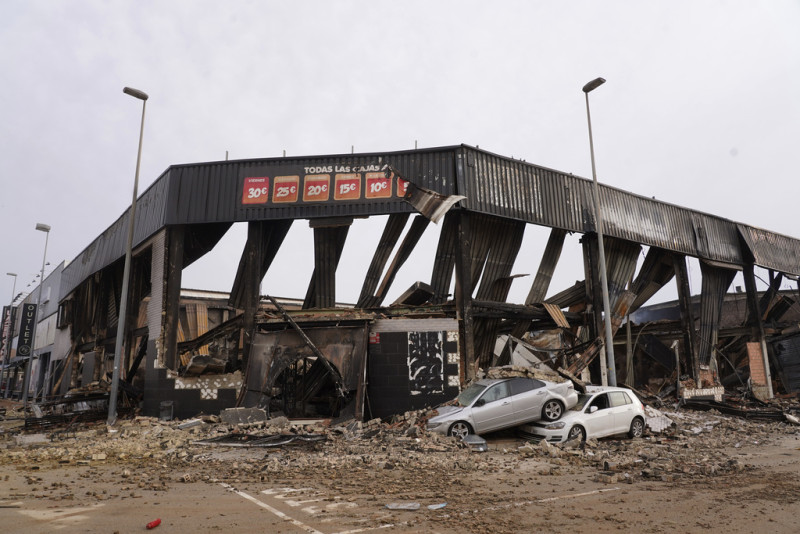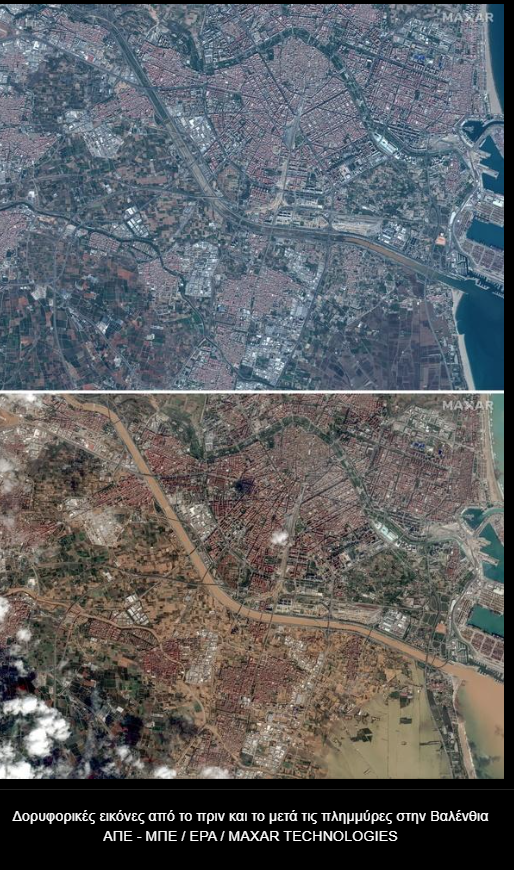Greenhouses and farms in southern Spain, known as the garden of Europe for its exports, were damaged by heavy rains
Cars piled on top of each other, trees uprooted, houses destroyed and mired in mud. This is the picture after deadly floods hit communities in Valencia, Spain, killing at least 158 people.
Rescue crews continue to search for people who have been buried with their cars and in their homes.
Watch a video of SKAI envoy Thanasis Gavou:
Storm damage late Tuesday and early Wednesday resembled the aftermath of a tsunami, with survivors left to pick up the pieces and mourn their loved ones.
An unknown number of people are still missing and more victims may be found.
“Unfortunately, there are dead people inside some vehicles,” Spain’s Transport Minister Óscar Puente said early Thursday.
Rushing waters turned narrow streets into death traps as the rivers destroyed homes and businesses, sweeping away cars, people and everything else in its path. The floods destroyed bridges and left roads unrecognizable.
Luís Sánchez, a welder, speaking at Associated Press said he rescued several people trapped in their cars on the flooded V-31 freeway south of the city of Valencia. The road quickly became a floating graveyard with hundreds of vehicles.
“I saw bodies floating. I screamed, but nothing,” Sanchez said. “The firemen took the elderly people first, when they were able to get in. I’m from around there so I tried to help and save people. People were crying everywhere, they were trapped.”
Regional authorities said late Wednesday that helicopter rescuers had rescued about 70 people trapped on roofs and cars, but ground crews had been unsuccessful.
“We are searching house by house,” Angel Martinez, one of 1,000 soldiers helping with rescue efforts, told Spain’s national radio station RNE from the town of Utiel, where at least six people have died.
A journalist of his Associated Press saw rescuers remove seven body bags from an underground garage in Barrio de la Torre.
“Our priority is to find the victims and the missing so we can help end the suffering of their families,” Spanish Prime Minister Pedro Sanchez said after a meeting with officials and emergency services in Valencia on Thursday, the first of three official days of mourning.
A violent deluge
Spain’s Mediterranean coast is used to autumn storms that can cause flooding, but this was the most powerful flash flood in recent memory. Scientists link this to climate change, which is also behind increasingly hot temperatures and droughts in Spain and the warming of the Mediterranean Sea.
See satellite images with before and after the disaster
Human-caused climate change has doubled the chance of a storm like this week’s deluge in Valencia, according to a quick but partial analysis Thursday by the World Weather Attribution, which includes dozens of international scientists studying the role of global warming in extreme weather conditions.
Spain suffered from a drought of almost two years, meaning that when the deluge occurred, the ground was so hard that it could not absorb the rain, leading to flash floods.
Spain’s national meteorological service announced that more rain fell in eight hours in the Valencian city of Chiva than in the previous 20 months.
Farms destroyed
Most of the damage was caused in the municipalities near the city of Valencia, the storms hit huge areas of the southern and eastern coast of the Iberian Peninsula. Two deaths were confirmed in the neighboring region of Castilla La Mancha and one in southern Andalusia.
Greenhouses and farms in southern Spain, known as the garden of Europe for its exported products, were also destroyed by heavy rains and floods. The storms caused a tornado in Valencia and a hailstorm that punctured cars in Andalusia. Homes were left without water as far south-west as Malaga in Andalusia.
Heavy rain continued further north on Thursday as Spain’s weather service issued warnings for several counties in Castegón, in the eastern region of Valencia, and Tarragona in Catalonia, as well as in southwestern Cádiz.
“This storm front is still with us,” the prime minister said. “Stay home and listen to the official advice and you will help save lives.”
Residents are looking for basic supplies
As residents get over the initial shock, so does the authorities’ handling of the crisis, the late warnings and the chaotic response.
Many survivors had to walk long distances through mud to find food and water. Most of their cars were destroyed and debris left by the storm made some roads impassable.
About 150,000 people in Valencia were without power on Wednesday and about half had power by Thursday. An unknown number had no running water and were relying on whatever bottled water they could find.
The region remained partially isolated with several roads cut off and train lines disrupted, including the high-speed service to Madrid. Officials said it will take two to three weeks to repair this damaged line.
And with emergency personnel focused on recovering the dead, survivors were left to find basic supplies and clean up the mess. Volunteers joined the locals in moving damaged vehicles, removing rubbish and mud.
Valencia regional president Carlos Mazon asked Thursday if the Spanish military could help distribute basic goods to the population. The Madrid government responded by promising to send 500 more soldiers, more national police and civil guards.
Looting
The National Police arrested 39 people for looting on Wednesday. The Civil Guard said it arrested 11 people for shoplifting, while its officers were also deployed to stop people stealing from cars.
Some people said they had to steal supplies, especially those without running water or a way to get to stores they didn’t destroy.
“We are not thieves. I work as a school cleaner for the council. But we have to eat. Look what I’m picking up: baby food for the baby,” said Nieves Vargas at a local supermarket whose doors had been pushed aside by water and were unmanned. “What to give the child, if we don’t have electricity.”
Source :Skai
With a wealth of experience honed over 4+ years in journalism, I bring a seasoned voice to the world of news. Currently, I work as a freelance writer and editor, always seeking new opportunities to tell compelling stories in the field of world news.














